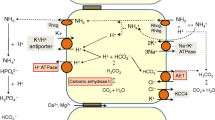Abstract
Objective
To assess the iodine deficiency status amongst school age children in district Pauri, Uttarakhand.
Methods
2067 children (age of 6–12 years) were included. Clinical examination of thyroid gland of each child was conducted. On-the-spot urine and salt samples were collected from children.
Results
Total Goitre Rate was found to be 16.8% and median Urinary Iodine Concentration level was 115 μg/L. Only 40.4% of salt samples had e 15 ppm of iodine.
Conclusion
There is a mild degree of iodine deficiency in school age children in district Pauri. There is a need of strengthening the National Iodine Deficiency Disorder Control Program.
Similar content being viewed by others
References
Directorate General of Health Services (DGHS). Policy Guidelines on National Iodine Deficiency Disorders Control Programme, New Delhi: DGHS, Ministry of Health & Family Welfare, Government of India; 2006.p.1–10.
Ministry of Health and Family Welfare (MOHFW). Annual Report 2004–2005. New Delhi: MOHFW.
Workshop. Health Policy Issues and Health Programme in Uttaranchal. Mussorie 2002. Department of Health and Family Welfare. Government of Uttaranchal, Dehradun.
Kapil U. National Nutrition Programmes in India. In: Mehta MN, Kulkarni M, editors. Child Nutrition — The Indian Scene. Bombay. Sai Creation and Advertising Co. Printing Press,1991;p.78–107.
International Institute for Population Sciences (IIPS) and Macro International, 2008. National Family Health Survey (NFHS-3), India, 2005-06: Uttarakhand. Mumbai: IIPS.
Assessment of Iodine Deficiency Disorders and Monitoring Their Elimination. A Guide for Programme Managers. WHO/UNICEF/ICCIDD. World Health Organization, Geneva; 2007.
Dunn JT, Crutchfield HE, Gutekunst R, Dunn D. Methods for Measuring Iodine in Urine. A joint publication of WHO/UNICEF/ICCIDD;1993;p.18–23.
Karmarkar MG, Pandav CS, Krishnamachari KAVR. Principle and Procedure for Iodine Estimation- A Laboratory Manual. Indian Council of Medical Research. New Delhi: ICMR Press; 1986:1–17.
Westgard JO, Barry PL, Hunt MR. A multi-rule Shewhart Chart for quality control in clinical chemistry. Clin Chem. 1981;27:493–501.
Author information
Authors and Affiliations
Corresponding author
Rights and permissions
About this article
Cite this article
Kapil, U., Pandey, R.M., Prakash, S. et al. Iodine deficiency status amongst school children in Pauri, Uttarakhand. Indian Pediatr 51, 569–570 (2014). https://doi.org/10.1007/s13312-014-0449-1
Received:
Revised:
Accepted:
Published:
Issue Date:
DOI: https://doi.org/10.1007/s13312-014-0449-1




